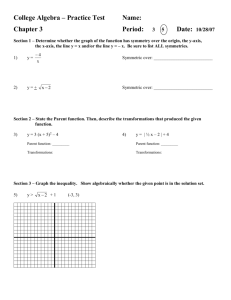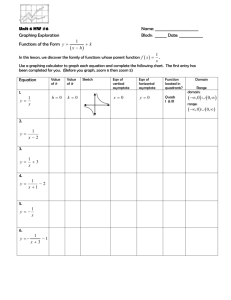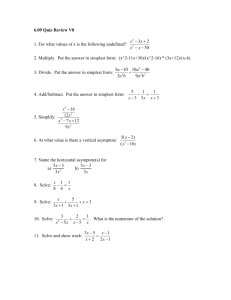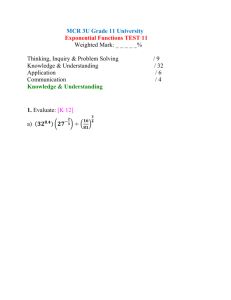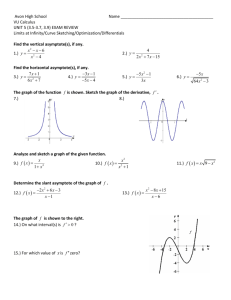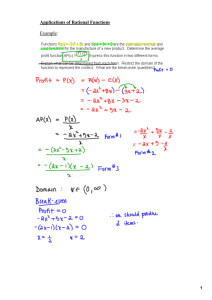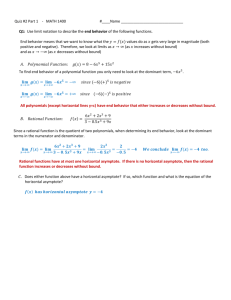File
advertisement
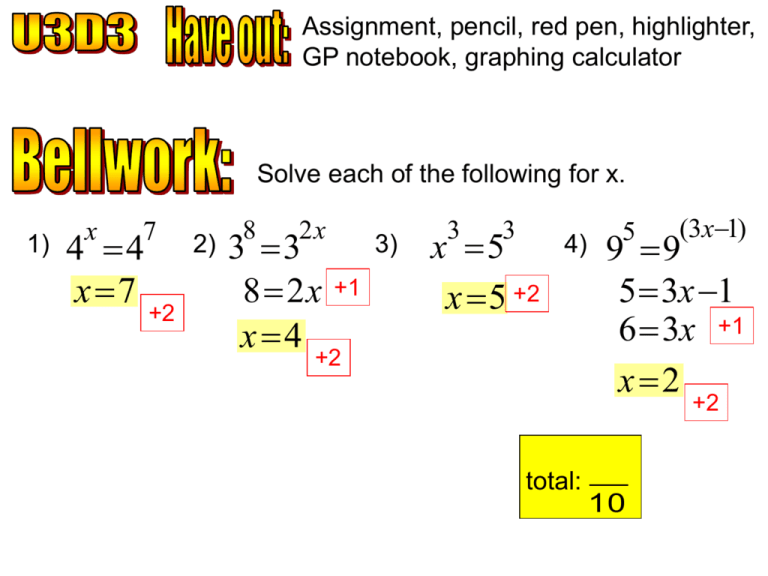
Assignment, pencil, red pen, highlighter, GP notebook, graphing calculator Solve each of the following for x. 1) x 7 4 4 x 7 +2 2) 8 2x 3 3 8 2x x 4 3) +1 3 3 x 5 x 5 +2 4) +2 5 (3x1) 9 9 5 3x 1 6 3x +1 x 2 +2 total: 10 Steps: Example #1: 4 x 64 x 3 1. Rewrite each base to make 4x 43x3 a common base. (Refer to x 3x 3 your powers worksheet.) 2. By the property of equality, if the bases are equal, then the exponents are equal. 3. Set the exponents equal and solve for x. x 3x 9 3x 3x 2x 9 9 x 2 Steps: Example #2: 25 x 625 4x 1. Rewrite each base to make 2(x) 4( 4x) 5 5 a common base. (Refer to your powers worksheet.) 2(x) 4( 4x) 2. By the property of equality, if the bases are equal, then the exponents are equal. 3. Set the exponents equal and solve for x. 2x 16x 2x 2x 0 18x 0 x 18 x 0 1 x 7 Steps: Example #3: 81 5x 9 1. Rewrite each base to make 1(5x) 2(x7) a common base. (Refer to 9 9 your powers worksheet.) 2. By the property of equality, if the bases are equal, then the exponents are equal. 3. Set the exponents equal and solve for x. 1(5x) 2(x 7) 5x 2x 14 2x 2x 7x 14 x 2 Determine the following information for the function below, and then graph it. 1 Enter the equation Y1 into your graphing calculator in Y= x 3 1 (x 3) Type into your graphing calculator: ___________. 1 0, 3 1) y-intercept: _______ 1 1 Y 03 3 Fill in the values for each table on parts (2), (3), and (5). Recall the steps for getting single values: VARS Use 2nd Y–VARS ENTER 2) What happens as x gets small? x 0 –1 –2 –10 –100 –1000 y1 –0.33 –0.25 –0.20 –0.08 –0.0097 –0.000997 y approaches 0. 1: Function 1: Y1 2nd QUIT ( ) Fill in the x–values here to repeat the steps. 3) What happens as x approaches 3? From the left From the right x 1 2 2.5 2.9 2.99 2.999 y1 –0.5 –1 –2 –10 –100 –1000 y is more negative. x 5 4 3.5 3.1 3.01 3.001 y1 0.5 1 2 10 100 1000 y gets larger. y 5) What happens as x gets large? x 6 10 100 1000 10 y1 0.33 0.14 0.01 0.001 vertical asymptote x –10 y gets closer to zero. x=3 10 1 Y1 x 3 Plot the points from the tables in parts (2), (3), and (5). –10 undefined so x 3. At x = 3, 4) When x = 3, the function is _________, asymptote there is a “invisible” vertical barrier called an __________. zero but never 6) As x gets large or small, y1 approaches _____, zero so we have a __________________ 0 horizontal asymptote at y = ___. reaches _____, x=3 x|x 3 7) Domain: ___________ y |y 0 Range: ____________ y 10 vertical asymptote y = 0 horizontal asymptote –10 x 10 1 Y1 x 3 –10 Investigate the given function. Be sure to label each graph. 1 Example #2: Reciprocal function f(x) x3 a) Algebraically solve for the y–intercept. 1 1 f(0) 03 3 1 0, 3 b) Algebraically solve for the x–intercepts. 1 0 x3 0 1 1 x3 cross multiply 0(x 3) 1 This doesn’t make sense. 0 times anything is 0, so 0(x + 3) = 0, not –1. There is no solution. Therefore, there are no x–intercepts. 1 Example #2: Reciprocal function f(x) x3 Type f(x) into your calculator, then use TABLE to help you y graph the function. x = –3 –3 there is a c) Since x ___, –3 vertical asymptote at x = __. ______________ 10 d) Is there a horizontal asymptote? y=0 0 As x , y ___ 0 As x – , y ___ x –10 10 0 is a Therefore, y = ___ horizontal asymptote. _________ –10 Investigate the given function. Be sure to label each graph. 1 2 Example #3: Reciprocal function f(x) x4 a) Algebraically solve for the y–intercept. 1 1 1 8 7 f(0) 2 2 04 4 4 4 4 7 0, 4 b) Algebraically solve for the x–intercepts. 1 0 2 x4 1 2 x4 cross multiply 2(x 4) 1 2x 8 1 2x 7 7 x 2 7 , 0 2 1 2 Example #3: Reciprocal function f(x) x4 Type the f(x) into your calculator, then use TABLE to y help you graph the function. x = –4 –4 there is a c) Since x ___, vertical asymptote at x = –4 ______________ __. 10 d) Is there a horizontal asymptote? –2 As x , y ___ –2 As x – , y ___ x –10 y = –2 10 –2 is a Therefore, y = ___ horizontal asymptote. _________ –10 Today’s assignment: Complete the worksheet

